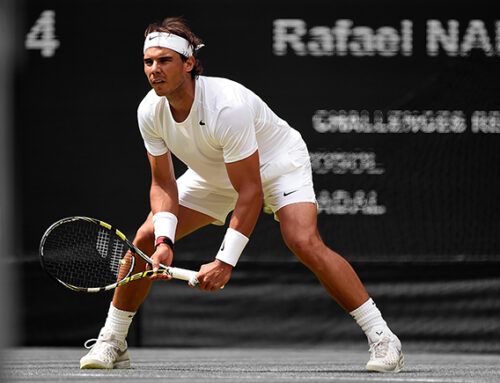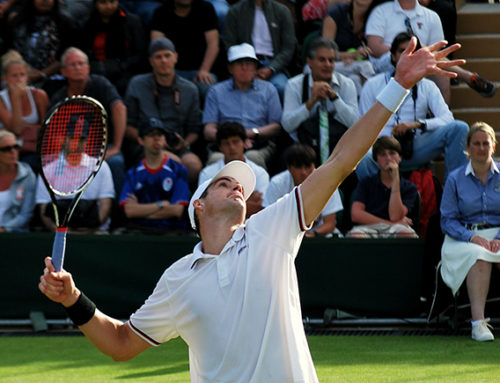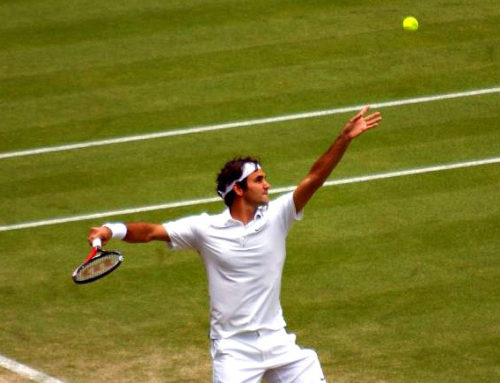2020 French Open Final: A Point With Rafael Nadal
Introduction
When Rafael Nadal and Novak Djokovic stepped onto Court Philippe Chatrier to contest the 2020 French Open Final, many predicted a resounding win for Novak. After all, Djokovic had come into the tournament with a 34-1 record for the year, his sole loss coming from a default due to a careless moment at the US Open.
Few would have imagined the match beginning with a 6-0 set for Nadal, nor the crushing victory he achieved over his main rival for the past decade. If it seemed Novak’s star was ascendent before the match, Nadal sent Djokovic crashing to the ground during it.
This was not by chance. Nadal hasn’t been lucky at Roland Garros 13 times. Rafa is the most dominant single-surface player in the history of the sport by a wide margin. Indeed we wrote briefly several years ago about some of the challenge Nadal presents on clay. In this article we will break down a point from this match, highlighting aspects of Nadal’s decision-making and positioning that led to his dominance on the day.
The Serve and Return
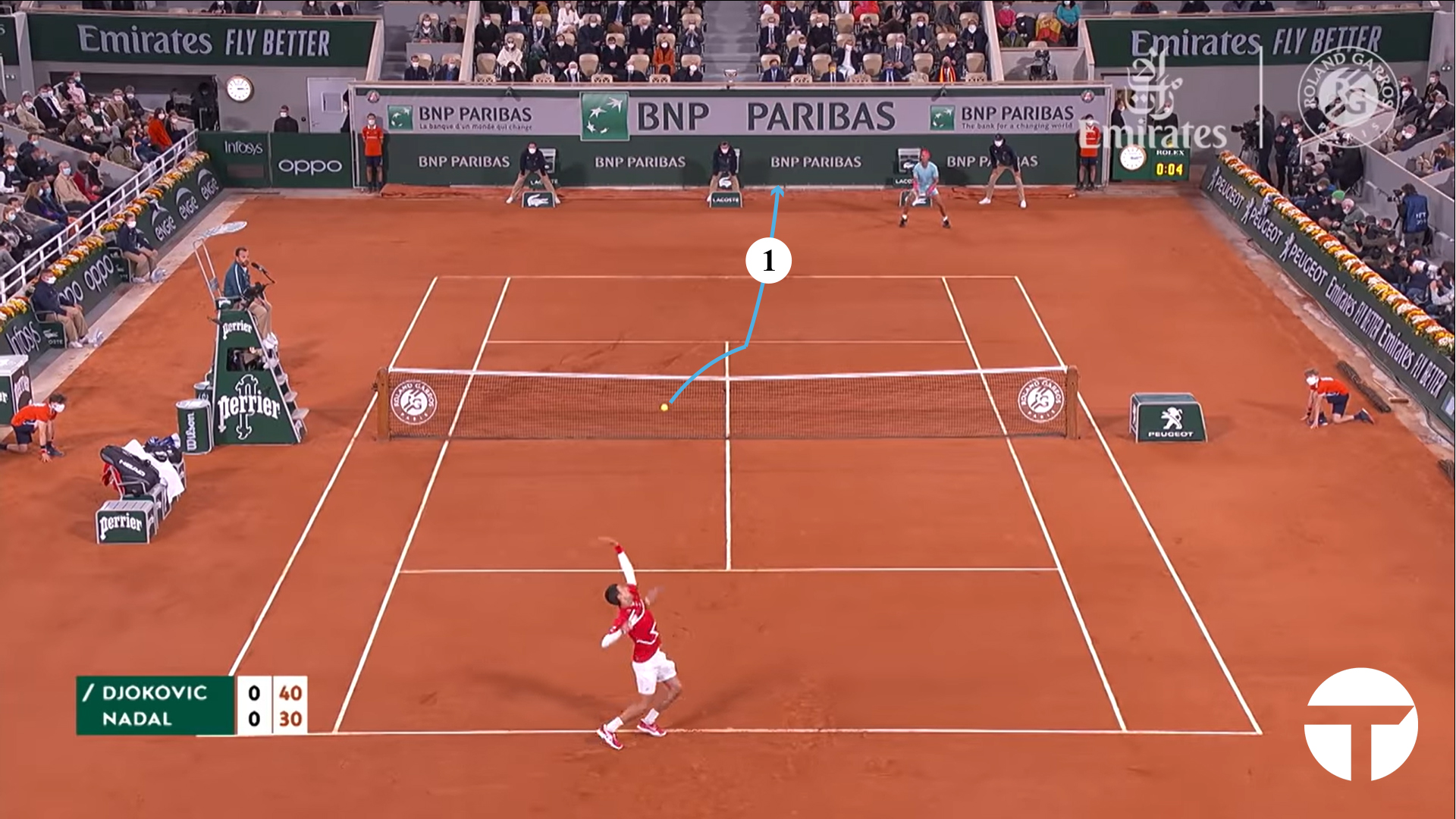
Much has been made of Nadal’s positioning on the return of serve. In recent years, he has retreated further and further behind the baseline to almost comical depth. At many tournaments, he cannot even be seen on the camera at times, and linespeople are forced to adjust their positions against the back walls to make room for him.
Nadal’s goals on the return of serve are simple: to make as many returns as possible, and hit returns that start the point in alignment with the way he wants to play the point. He brings a cohesive return strategy to the table in the same way Agassi did – just of a very different style. Agassi’s game was centered around hard, flatter groundstrokes, and his return game was a match to that. Nadal wants to hit high, heavy groundstrokes during the rally, and returns accordingly.
The point opens with a good quality serve up the T from Novak. While Novak’s first serve was generally pretty poor through most of this match, this particular serve was a strong one.
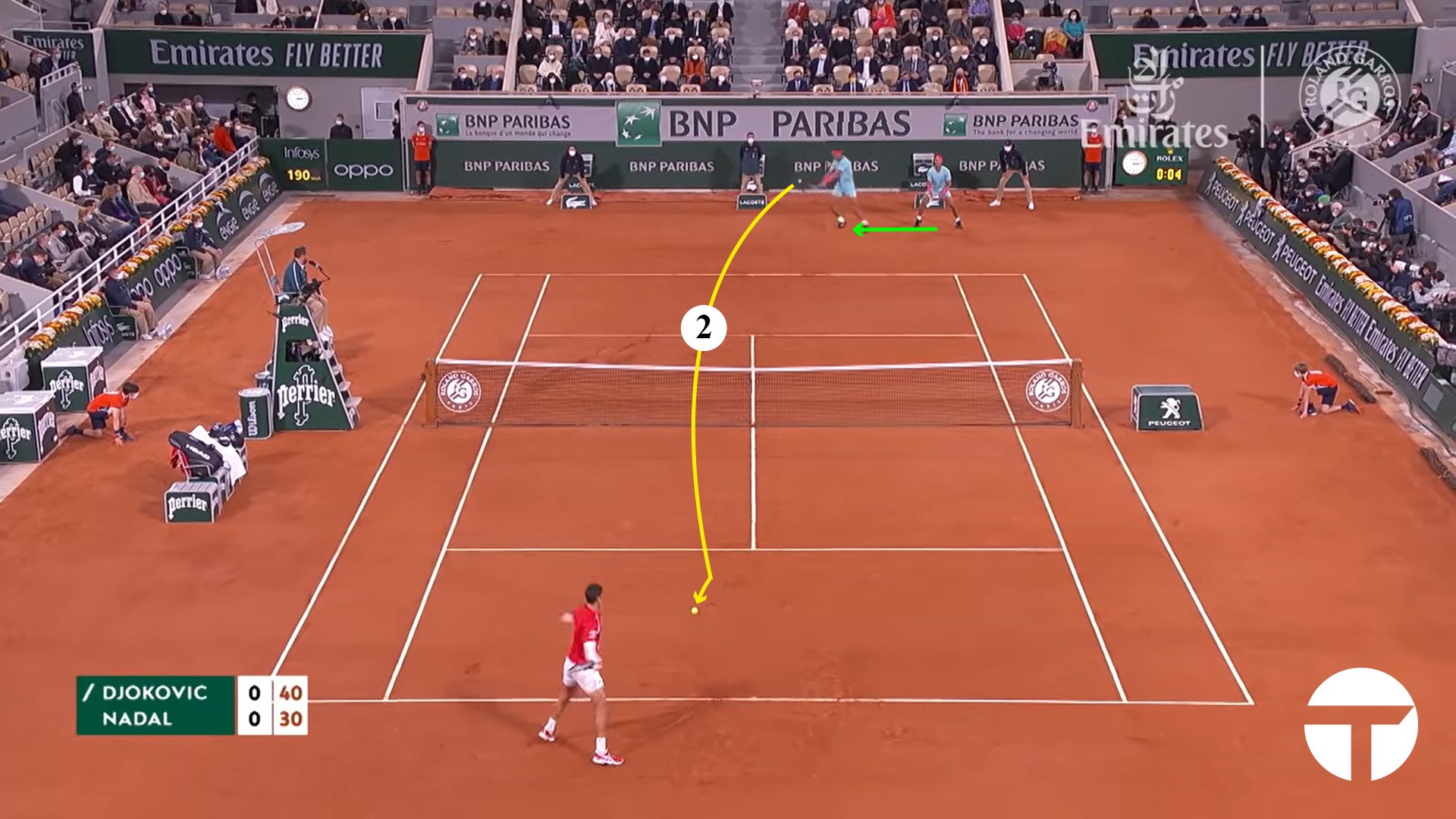
First note Nadal’s movement to the return. Positioned so deep, he is able to move laterally to the ball, keeping his balance neutral. This is a theme we will see throughout his clay court play. Nadal hits a high, looping backhand return with the goal of forcing Djokovic back and starting the point in neutral.
As we continue to move through the rest of this point, we will see that the players are faced with a series of choices that are not as simple as they might first appear. Here, Nadal has presented Djokovic with his first real choice during the point. Djokovic stepped up to the line knowing where he wanted to serve – everything after that is a reaction for both players.
The First Fork
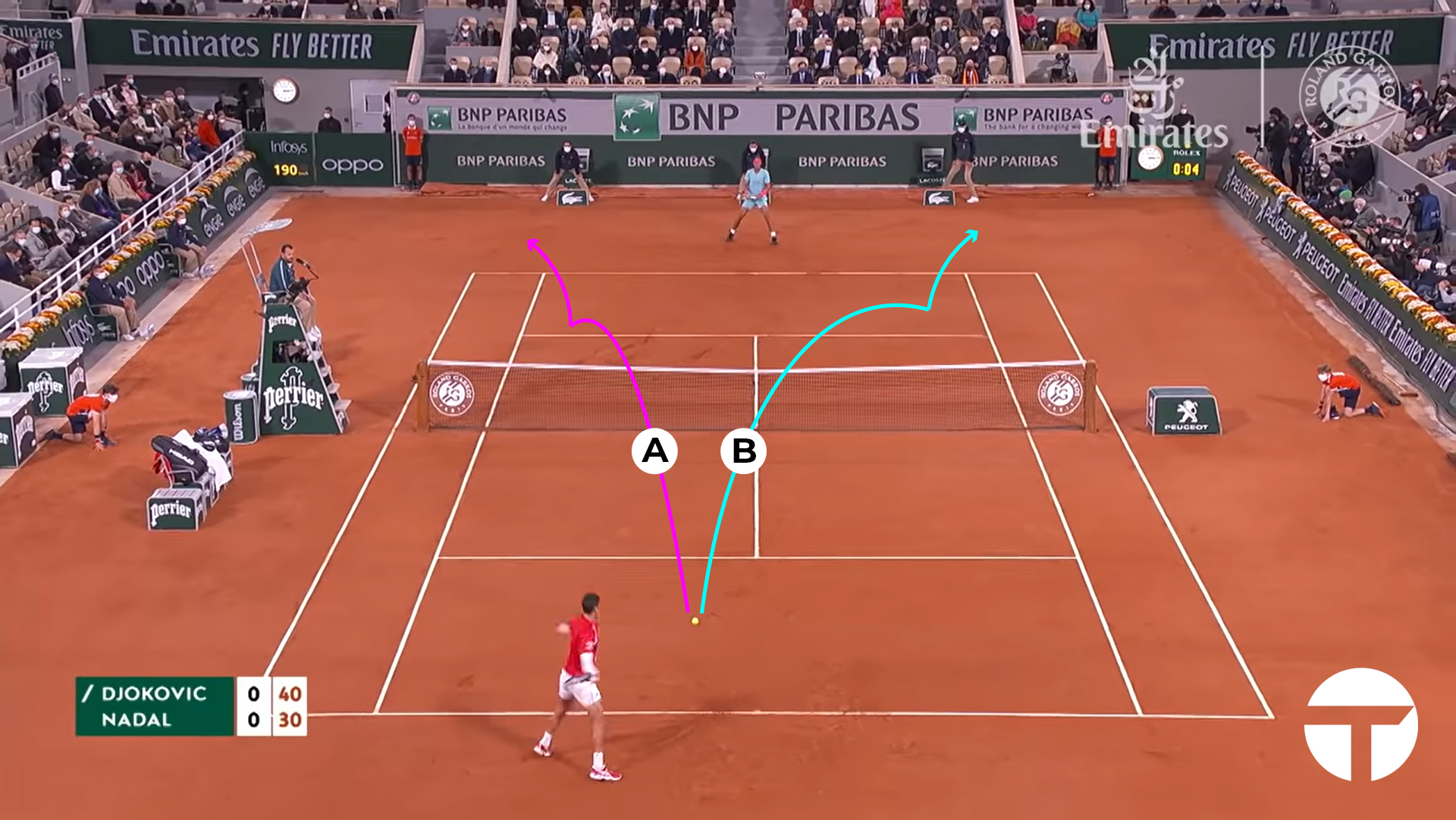
Nadal’s goal was to start the point as close to neutral as possible. Rafa didn’t quite achieve his goal in this case. Although he did push Novak back behind the baseline, Djokovic has control of the point from this first ball. Novak has two good options with his forehand – A & B. In chess, this would be a fork – being able to attack two pieces simultaneously. In high level tennis, these situations where a player has two viable attacking options usually lead to a victory in the point.
Rafa must respect both options, and positions himself accordingly. Approximately central in the court, he has retreated fairly deep behind the baseline to allow himself time to track the ball down on the clay.
Nadal isn’t the only one facing choices here. For Novak there is risk in both directions. Hitting to Nadal’s forehand runs the chance of immediate reprisal. However, being overly predictable and playing to Nadal’s backhand can give away the advantage.
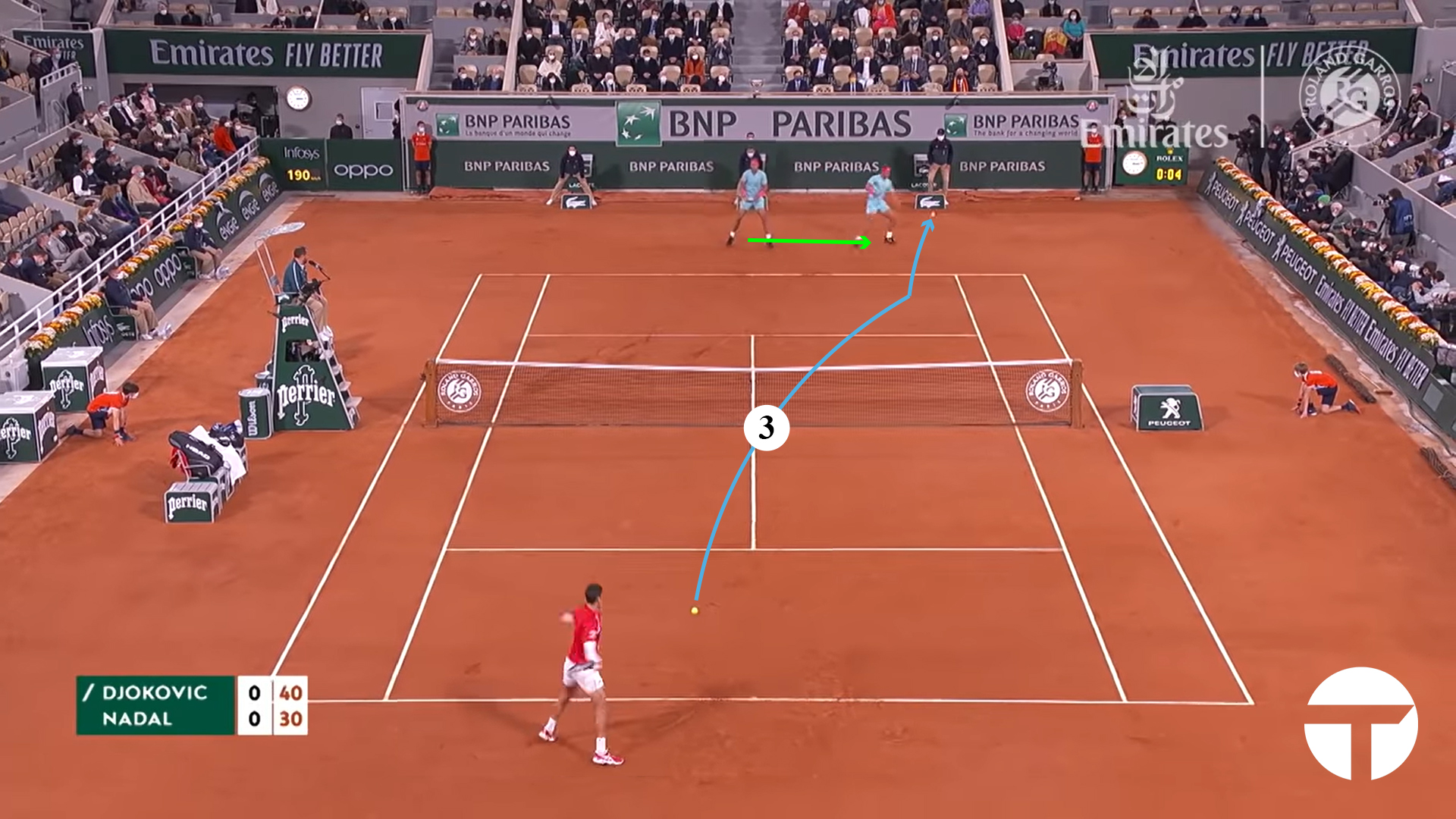
Djokovic goes with option B. Opponents have had good success over the years attacking Nadal’s forehand. After all, Rafa has spent almost 2 decades hitting forehands from the deuce court at the professional level. That’s the position Nadal prefers to construct his points from when he can, so Djokovic seeks to catch him off balance by attacking the forehand corner.
It works, to a degree. He does succeed in catching Nadal slightly off-guard, but Nadal’s excellent positioning neutralizes this. Note how Rafa is able to move laterally to the ball without giving up any extra space. Nadal is not forced backwards by Novak’s attacking ball.
Getting To Neutral
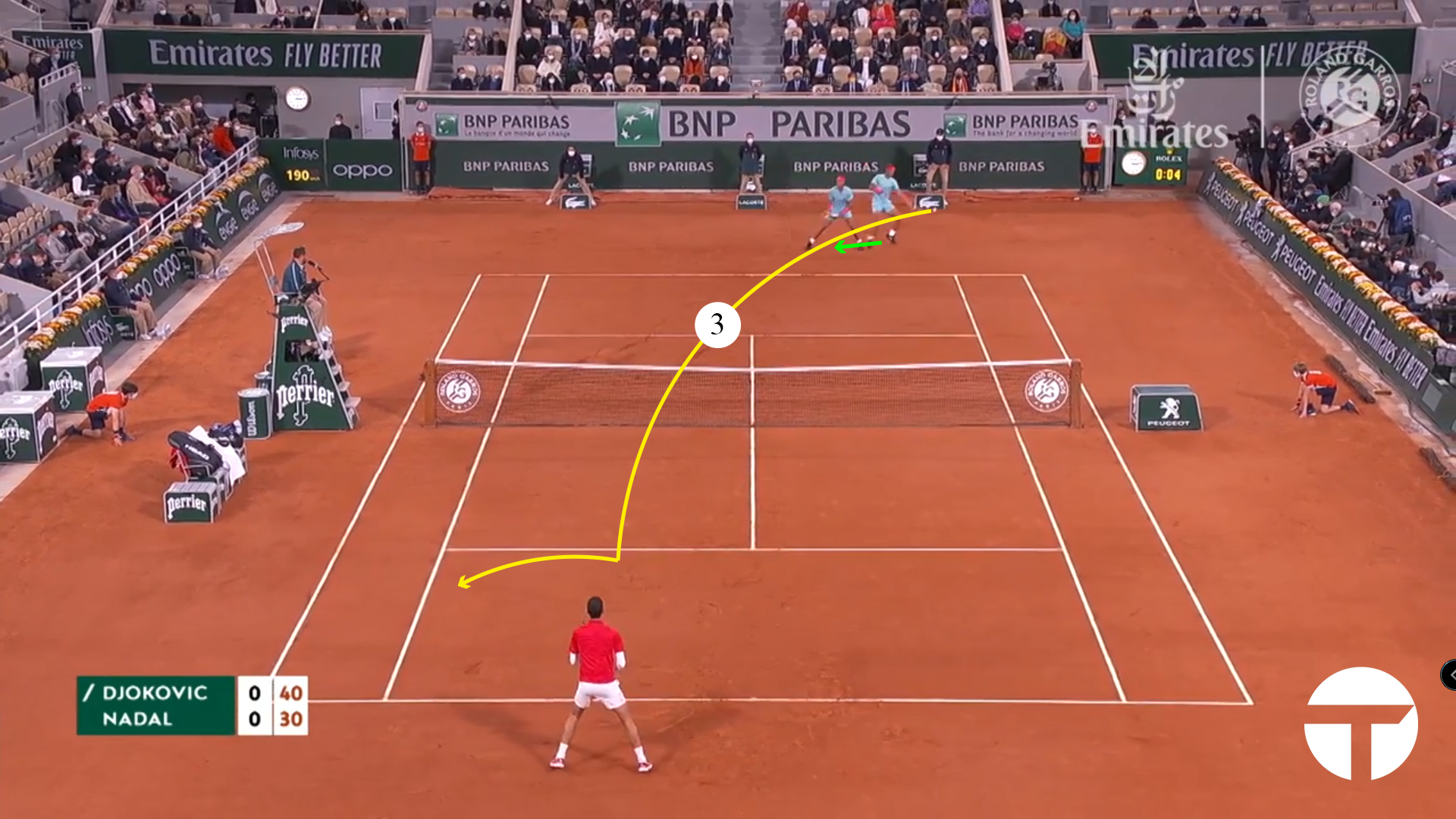
Nadal’s forehand here is almost entirely predictable. Although he is hitting slightly off the back foot, like any elite player Rafa is still able to generate significant power and spin. Nadal takes the ball cross-court, establishing himself in the rally in a truly neutral position for the first time.
Rafa could have taken this forehand down the line, but doing so would have put him immediately on the move again to cover the cross-court forehand from Djokovic. Let’s keep front of mind that Nadal wants to hit forehands, and constructs his points with this in mind.
Knowing that he has hit a high quality ball, Nadal recovers slightly forwards and towards the center. Had his shot been more defensive or lower quality, Rafa would have recovered backwards into a deeper position.
Cat And Mouse
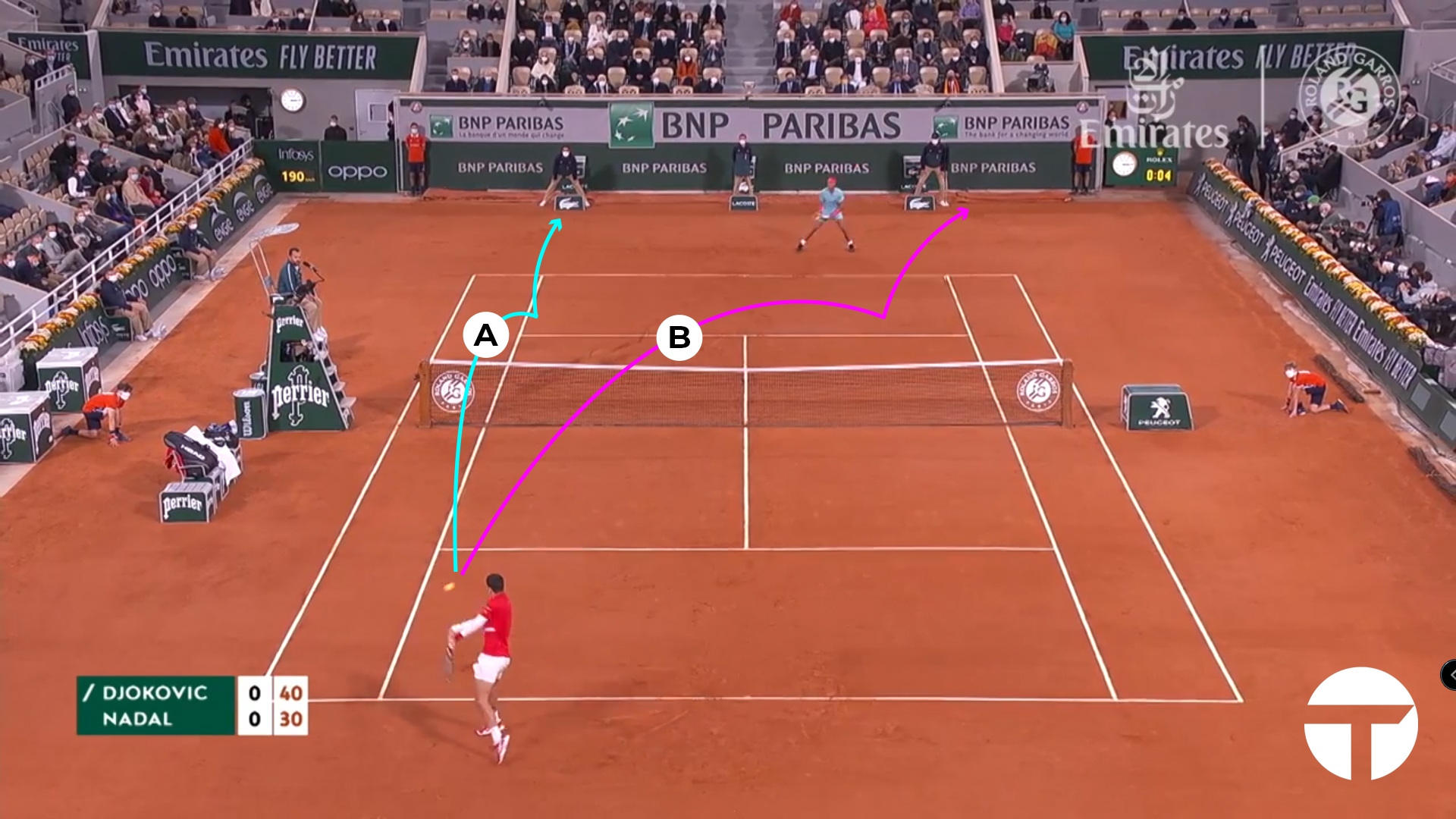
If we think back two shots, Novak had a middle of the court forehand that he could attack in either direction. Two shots later, Novak is hitting a backhand from behind the baseline in his own ad corner. Djokovic is faced with much the same choices he had two shots ago, but from a worse position. If Novak takes his backhand cross-court, he is trapping himself into a backhand-forehand rally where he is at a disadvantage.
However shot “A” is a high risk play. Novak’s margins down the line aren’t as good here, and he is not really in an attacking position. While Novak can take this backhand down the line, doing so is a genuine risk. Nadal is in good position to cover the shot, and for Novak to go down the line here without genuinely hurting Nadal would leave him open to the counter attack.
Now the cat and mouse game begins in earnest. Nadal’s forehand is the biggest weapon on the court. Both players know it, and much of their shot selection is driven by this knowledge. Novak wants to avoid giving Nadal forehands he can attack, but must still respect Nadal’s excellent backhand. Nadal meanwhile must try to maneuver the ball around to get himself a forehand, without putting himself out of position. Djokovic has the ability to hurt him off both wings, and Rafa must respect that.
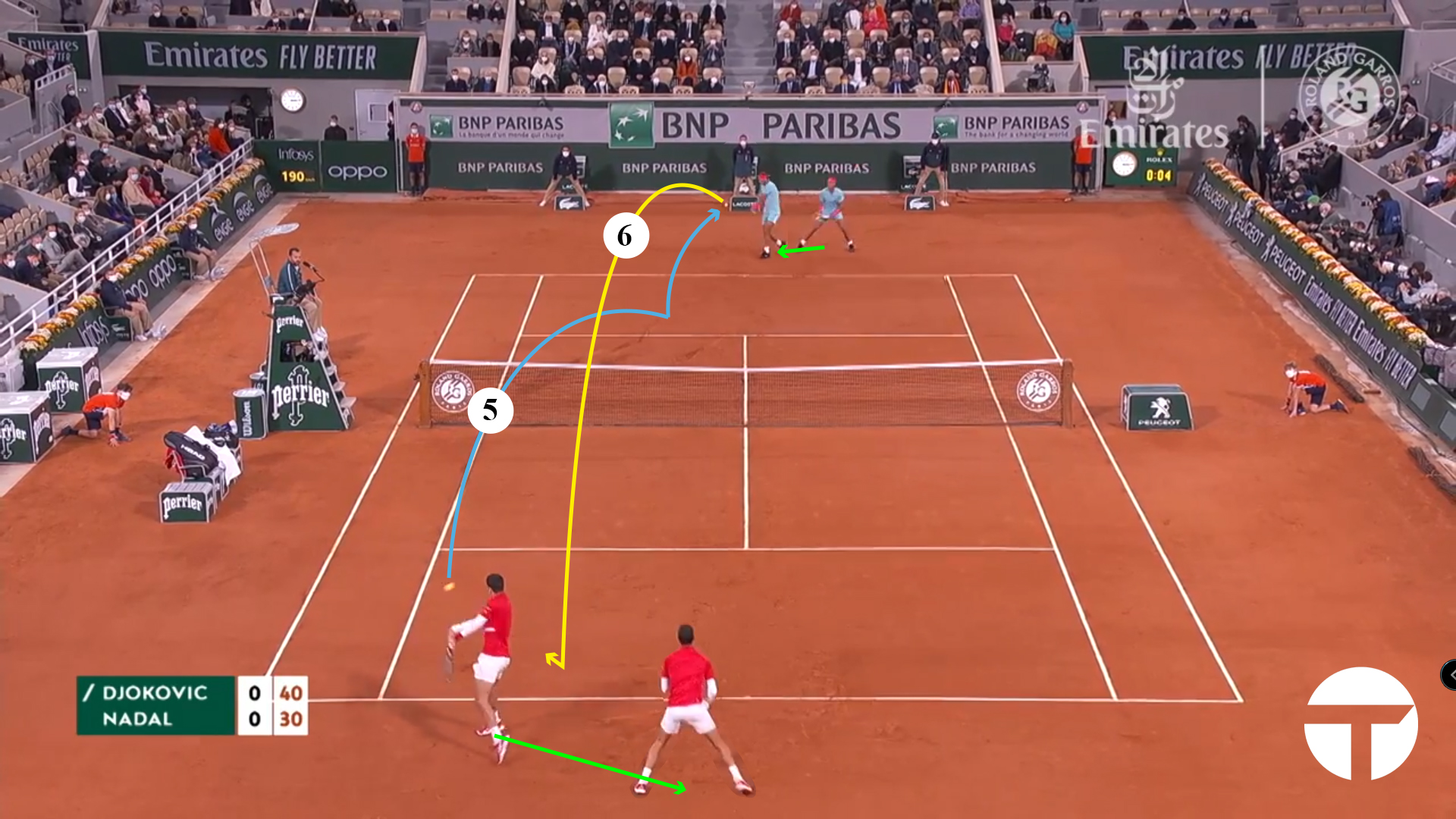
Djokovic splits the difference. Not wanting to give Nadal the forehand, but also knowing he isn’t in position to be aggressive, Djokovic looks the backhand into the backhand-center of the court. This is a safe play, as Novak knows that Nadal doesn’t have time to run around the backhand. Rafa’s backhand as it its most dangerous from wider positions in the court – he cannot create as much angle from more central positions.
Because of his good recovery position after his previous shot, Nadal is able to take but two steps slightly forward for this next shot. Nadal knows he has a slight advantage now. When we look at Djokovic’s recovery position, we see that Djokovic knows it also.
We can often tell how players feel about their chances in the point by looking at their recovery positions. When a player feels good about their control of the point they recover forwards. When they have lost some advantage, they recover backwards. Djokovic moves back because he knows Nadal has the upper hand.
Nadal does something quite clever here. He has the advantage, but it is a positional one. Rafa is not in a truly attacking position – he is not yet in the end game of this point. So he plays the ball straight ahead, high and deep. Rafa knows that Djokovic had to recover to a very central position, he is able to force another backhand for Novak without having to push the sides of the court.
Falling Behind
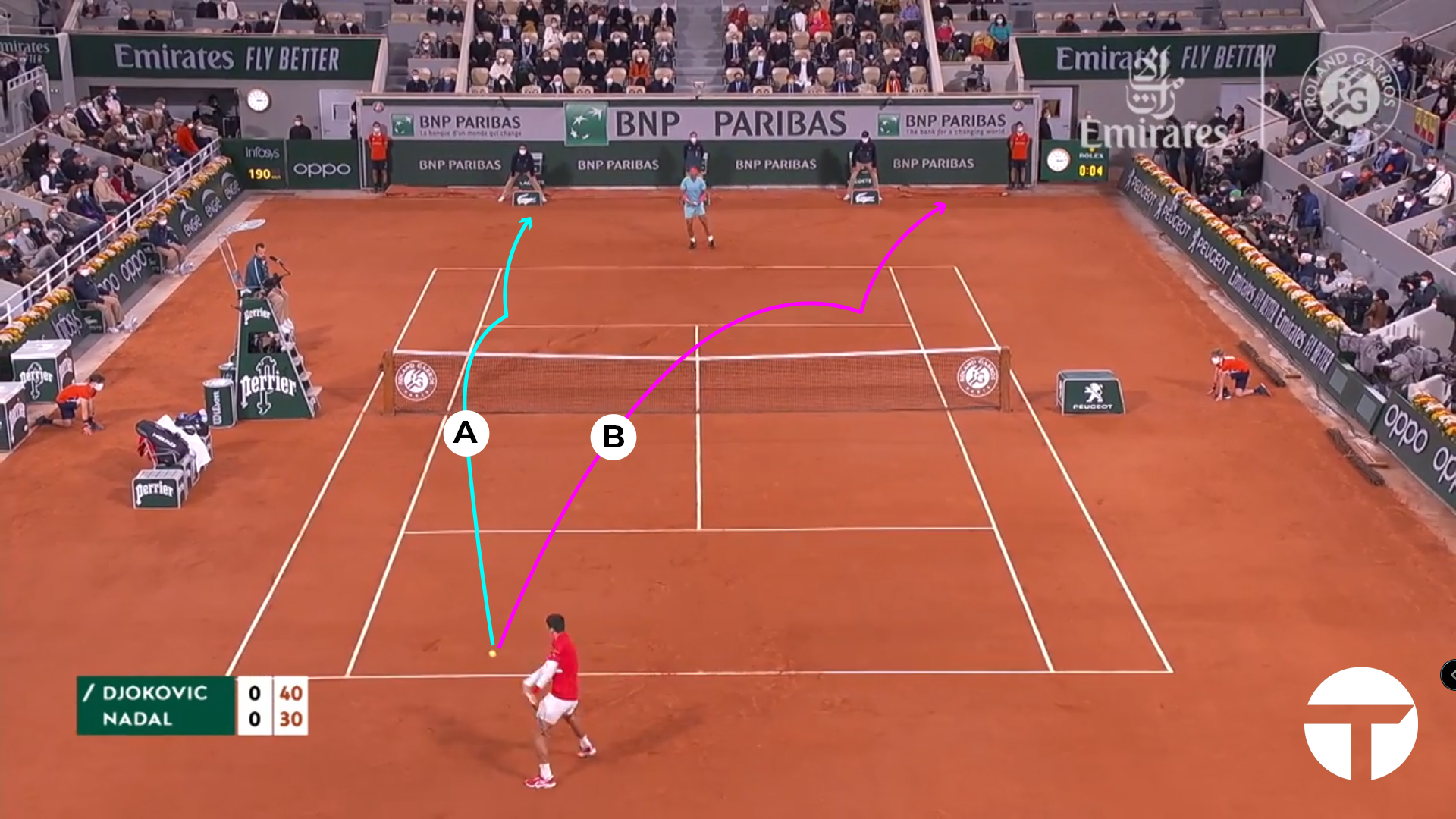
This position should look fairly familiar by now. Novak is facing the same choices he had earlier, but from an even worse position still. Djokovic is deeper behind the baseline, and has less angle to work with. Option “A” is even higher risk than it was earlier, but “B” still has the same dangers it had before. With each passing shot, Djokovic’s position in this point has weakened, and Nadal’s has strengthened.
It may not seem like it at a glance, but Nadal has Djokovic in real trouble here and Novak knows it. What would look like a reasonably neutral rally backhand to many is in actuality a highly dangerous position.
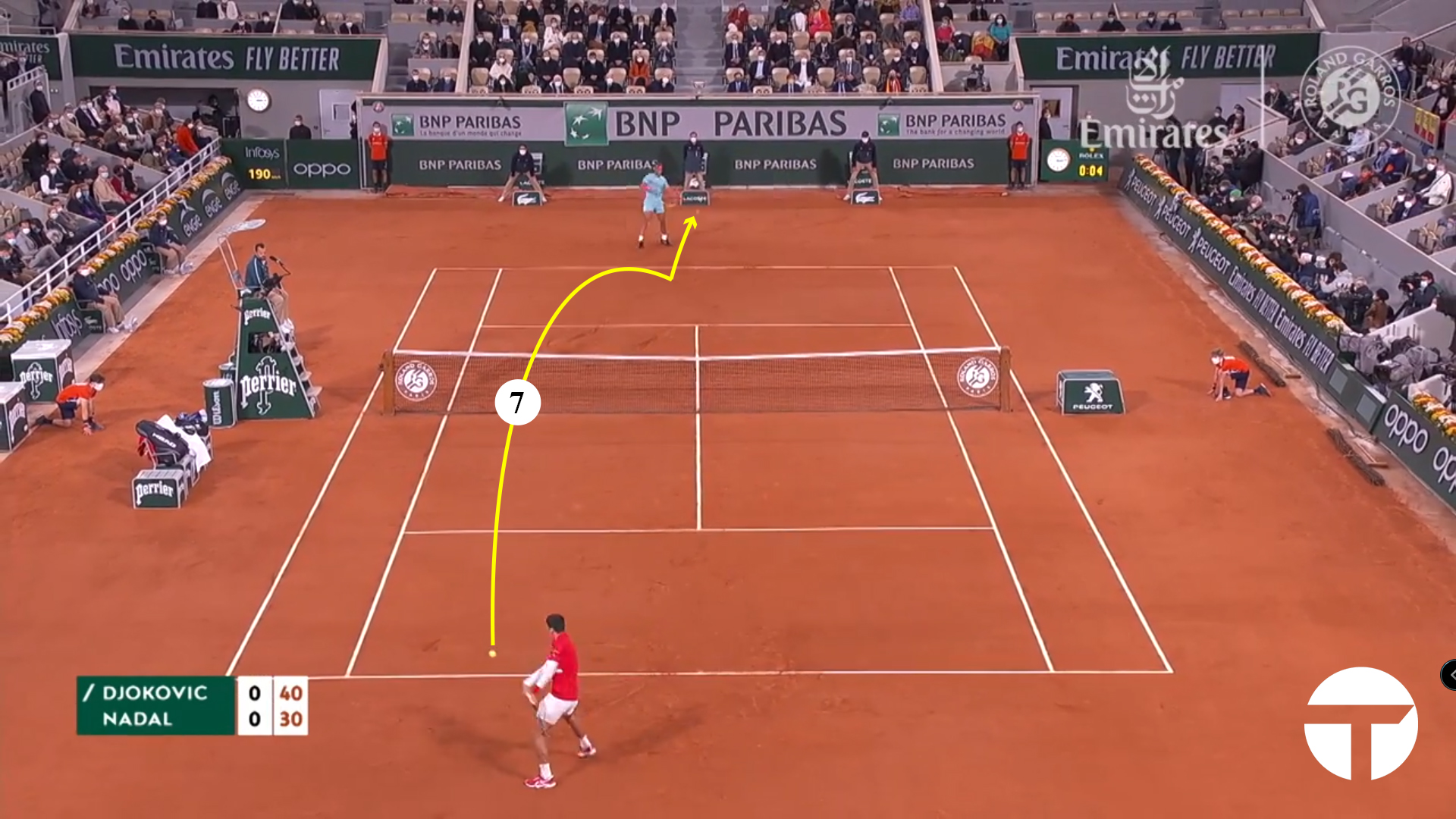
Djokovic abdicates the choice. In a bid for safety, he plays the ball almost straight head in a mirror of his previous backhand. Perhaps Djokovic thought he would sneak the ball to Nadal’s backhand again. Perhaps he thought this would be enough to stay close to neutral in the rally.
Whatever his intent, Novak puts the ball too close to the center of the court. A small shuffle to his right, and Nadal is hitting a forehand from a central position. It’s important to note that this is the second ball in a row that Rafa has barely had to move for in order to hit. Novak tried to avoid committing to anything, but you cannot delay making real choices against Nadal on clay. Part of the challenge is that Nadal is always asking questions to which there are no easy answers.
The Second Fork
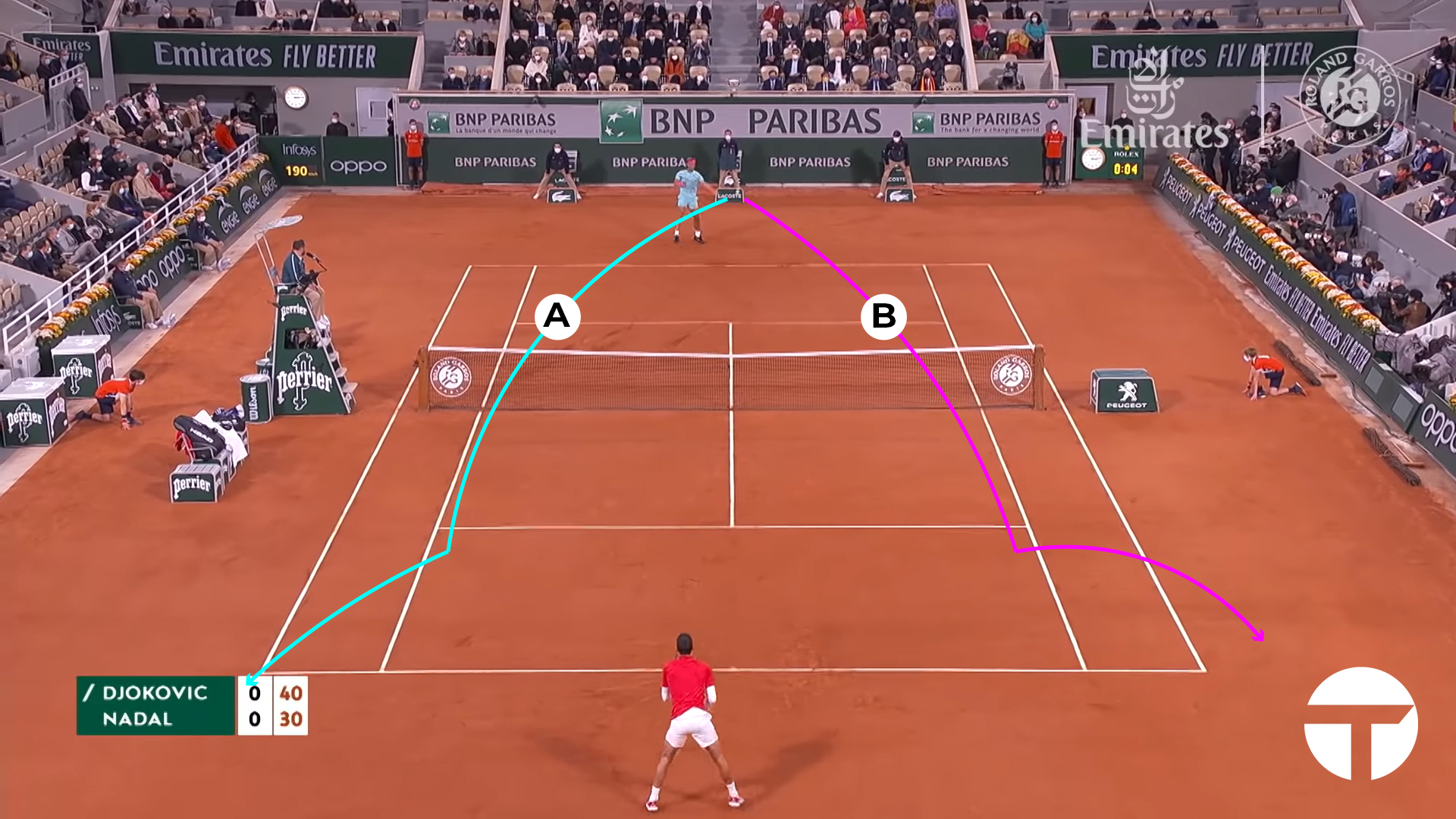
As it required minimal movement, Nadal is hitting a forehand while balanced and prepared. Rafa has two viable attacking options, and can hurt Novak with either one. Having the heavier forehand of the two, Nadal can hit with more angle than Novak. This gives him a wider spread of attack off this position.
Djokovic is frozen – stuck behind the baseline and having no ability to predict, he is trapped into pure reaction. On any surface this is a difficult predicament, but on clay perhaps more so. On the dirt, we pay a greater penalty for being off-balance than we do on any other surface. Novak is forced to take a very neutral position with a large amount of court to cover on his next ball.
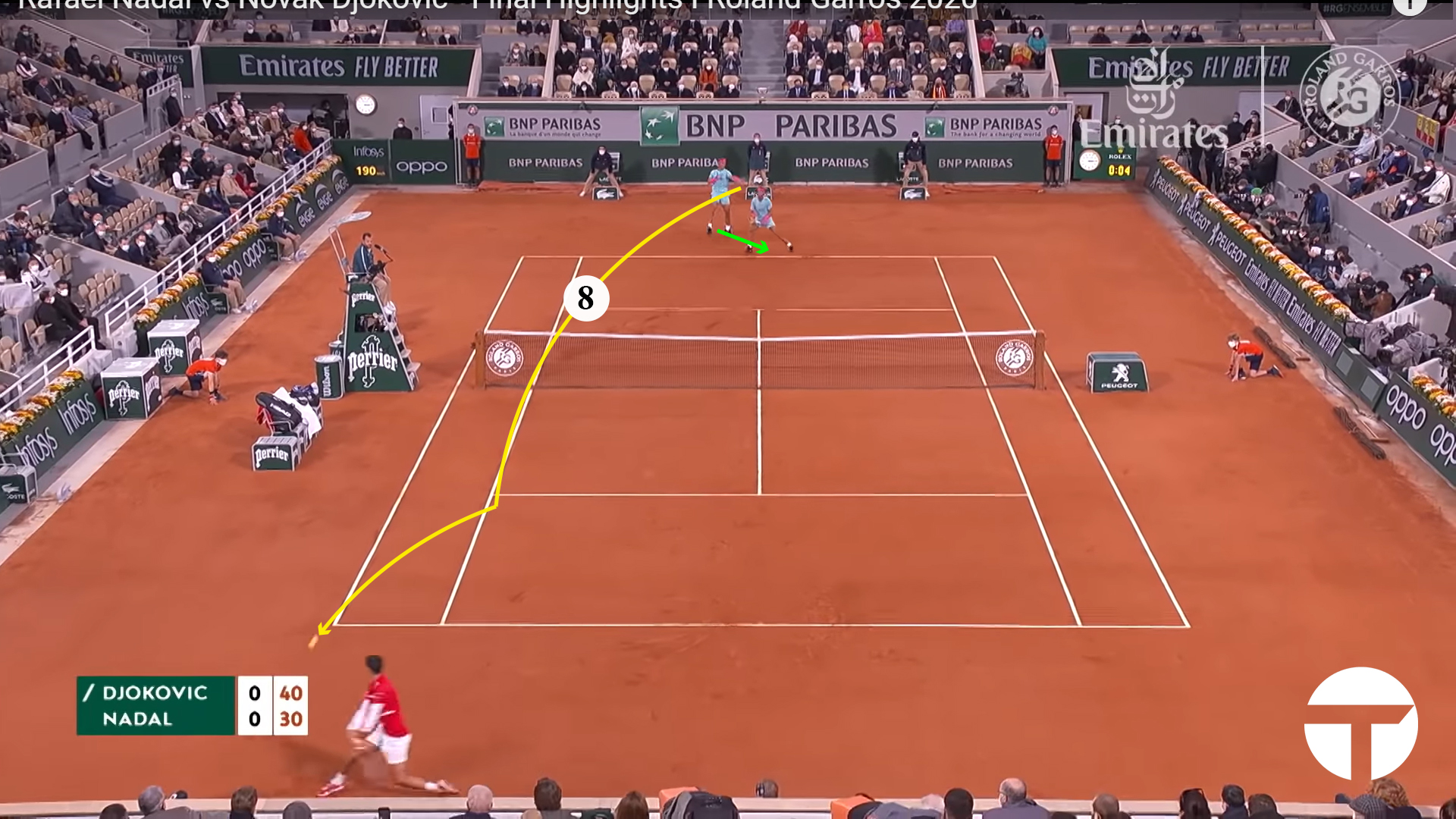
Nadal attacks. Ripping his forehand cross-court, Nadal opens the court up. This forehand isn’t just heavy – it is angled. Note how close to the service line the ball bounces, forcing Novak to move more out of position laterally. If Nadal couldn’t have attacked either side equally, Djokovic would have been able to position higher up the court and cut this ball off. However as he was forced to react, Novak’s deeper court positioning puts him in a poor position here.
The other thing to watch is Nadal’s recovery position. Nadal has been able to move straight laterally or slightly forward to every single groundstroke in the rally so far. He has accomplished this by careful positioning – taking up the right place on the court between shots in depth as well as width.
The fact Nadal recovers forwards here is significant. Rafa is a shark who smells blood in the water. He steps up because he anticipates a more defensive reply from Novak, and for good reason. Djokovic is in real trouble at this point, with limited options.
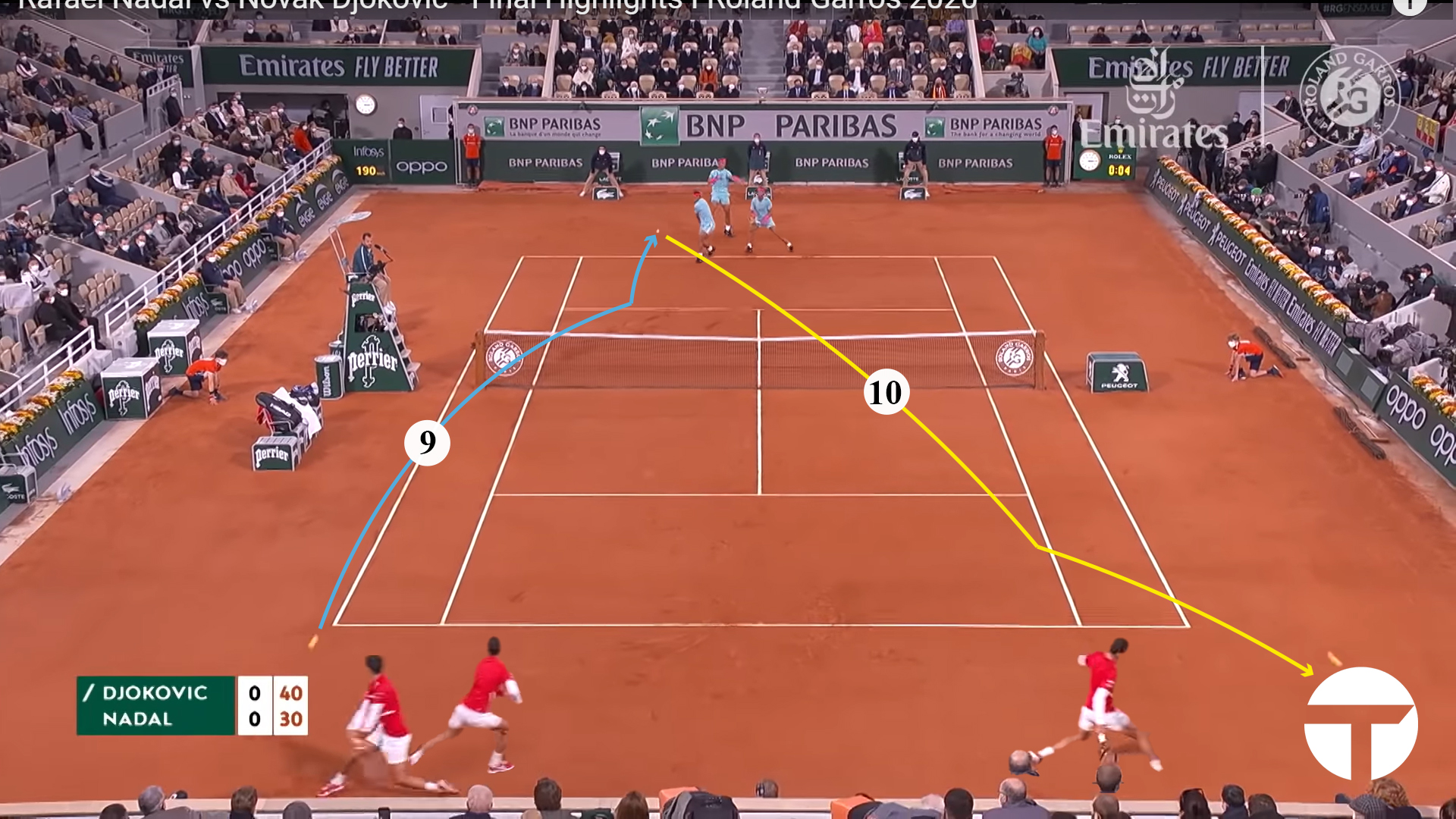
Against most players, Novak’s backhand down the line combined with his foot speed would have been enough to keep him in this point. However Nadal’s clay court anticipation and positioning is too good. Expecting the shorter reply, Nadal recovered forward, then stepped in to take this backhand early.
If Nadal had stayed in a deeper position after his forehand hit he would have been far less likely to finish the point here. Being even one step deeper in the court might not have been enough to get the ball past a player as quick as Djokovic.
Recovery Positions
Any high level player needs to be able to generate power and spin off the back foot. That said, there are advantages to not having to move diagonally backwards to shots. Hitting off the back foot requires more athleticism. Hitting from deeper in the court makes it more difficult to find angles, and gives more time to our opponents.
One of the things that makes Nadal so formidable on clay isn’t just his forehand, but his positioning. For every single shot in this rally, including the return of serve, Nadal was able to move either straight sidewards or forwards to his next shot. Even Djokovic’s one aggressive shot of the point didn’t push Nadal back in the court.
This is not because Nadal took everything on the rise, or refused to give up ground in the way that someone like Davydenko or Agassi might have. Rather, Nadal’s intuitive sense of the flow of the point allowed him to mostly predict what was going to happen next. On the one shot where he couldn’t predict (the forehand Djokovic hit right after his serve) Rafa positioned himself slightly deeper to compensate.
Conclusion
This is a busy point, for all that it was only 10 shots in total. We can see and learn many things from it when we take the time to break down the different positions and decisions each player faces and takes during the rally. Nadal and Djokovic are battling on several different fronts here.
The first is over Nadal’s forehand. Djokovic wants to avoid letting Nadal dictate play with his forehand. This means either keeping play to Nadal’s backhand, or only allowing Nadal to hit forehands that are more defensive in nature.
The second is over positioning. Even though Nadal’s forehand is the biggest weapon on the court, both players are perfectly capable of hitting a winner off either wing. This means the player with the better court positioning is likely to come out on top.
On hard courts, this second battle is easier for Djokovic to win against Nadal than it is on the clay. Novak can take Nadal’s forehand on the rise on hard courts at least some of the time. The sometimes unpredictable clay court bounce combined with Rafa’s heavy, and often off-center rotation, make taking the ball on the rise significantly more difficult.
While no two points were identical in this match, these two things were underlying the decisions each was making throughout the match. We can see these kinds of complexities in every matchup. The battles are not always obvious, and the clues as to who is winning them can be subtle. Recovery positions, movement to the ball, and forks are all good indicators of how things are progressing.

